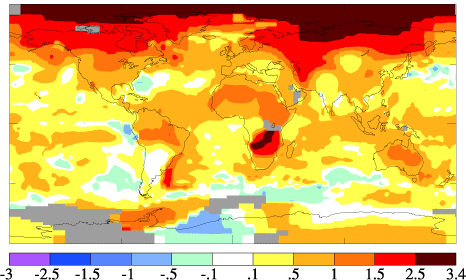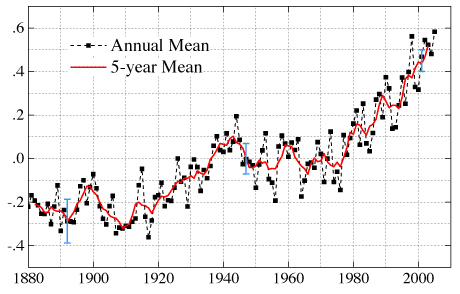Geotimes

Untitled Document

Web Extra
Monday, January 30, 2006
2005 was warmest year on record
 The record-breaking
number of named storms during the 2005 hurricane season may have dominated weather
news, but at the same time, another record was in the making: The year now stands
as the warmest on record, according to some climatologists.
The record-breaking
number of named storms during the 2005 hurricane season may have dominated weather
news, but at the same time, another record was in the making: The year now stands
as the warmest on record, according to some climatologists.
This map depicts areas that have warmed
(yellow to red) and areas that have cooled (blue to purple) during 2005. Significant
warming was especially evident in measurements from the Arctic, the inclusion
of which helped 2005 surpass 1998 as the warmest year on record. All images
are courtesy of NASA.
Global surface temperatures have increased about 0.6 degrees Celsius (1 degree
Fahrenheit) since the mid-1970s. That increase culminated in 2005 with the highest
surface temperatures ever recorded, according to a report released this month
by James Hansen, director of NASA's Goddard Institute for Space Studies, and
colleagues.
Other groups, including the National Oceanic and Atmospheric Administration
(NOAA) and the World Meteorological Organization (WMO), ranked 2005 as the second
warmest year behind 1998, using different analytical techniques. But whether
2005 comes in at the first or second warmest year, climatologists agree that
the five warmest years since the 1890s have occurred in the last decade.
Hansen and colleagues' analysis included global surface temperature measurements
from land-based stations, satellites and ships. They found that temperatures
were above normal for most of the northern hemisphere, with the largest warming
measured in Alaska, Siberia and the Arctic. The inclusion of anomalous warming
in the Arctic, Hansen wrote, may have put 2005 above NOAA and WMO estimates,
which excluded that region.
The report shows that the previous decade's jump in temperature was part of
a more gradual acceleration of warming that has occurred since measurements
began in the late 1800s. The trend is "consistent with expectations"
from climate models and "coincides" with the increase of human-caused
greenhouse gases, reinforcing the need to discuss how greenhouse gas emissions
can be curbed, Hansen's team wrote.
Jonathan Overpeck, an atmospheric sciences professor at the University of Arizona
in Tucson, says "it's clear" that some of the greenhouse gases are
coming from human activity, rather than only from natural sources. "That's
pretty indisputable at this point," he says. But exactly how much of that
warming trend is due to humans and how much is part of Earth's natural climate
fluctuations is the focus of scientifically and politically heated debate.
 Contributions
to warming from natural variations exist on the scales of years and decades,
such as El Niño and La Niña, Overpeck says. Indeed, the warming
effects of El Niño contributed to the previous record-warm year of 1998.
Also, natural warming contributions come from volcanoes and changes in solar
output, Overpeck says. Last year, however, was neutral to the effects of El
Niño and La Niña, he says, and other natural fluctuations "can't
explain this accelerated warming that's going on now."
Contributions
to warming from natural variations exist on the scales of years and decades,
such as El Niño and La Niña, Overpeck says. Indeed, the warming
effects of El Niño contributed to the previous record-warm year of 1998.
Also, natural warming contributions come from volcanoes and changes in solar
output, Overpeck says. Last year, however, was neutral to the effects of El
Niño and La Niña, he says, and other natural fluctuations "can't
explain this accelerated warming that's going on now."
This graph shows
the number of degrees Celsius that annual global surface temperatures deviated
from the mean temperatures recorded between 1951 and 1980 (set to zero). An
anomalous warming acceleration is evident beginning in the mid-1970s.
That warming contributed to warmer sea-surface temperatures, which Overpeck
says might have led to the record-breaking number of named storms in the 2005
hurricane season. The high temperatures might also account for the severe drought
conditions that struck the southwestern United States. Those relationships,
however, cannot be confirmed with "statistical confidence."
As for what temperatures the future might hold, Hansen and colleagues wrote
that impending El Niño conditions for 2006 and 2007 will boost global
temperatures such that the "record will almost surely be broken."
Overpeck says, however, that "El Niños are not all bad." While
the temperature record might be broken again, increased precipitation could
allow the Southwest to rebound from drought conditions, and typically, he says,
"El Niño means fewer hurricanes too."
Kathryn Hansen
Links:
NASA
GISS Global Temperature Trends: 2005 Summation
"2005
warmest year in over a century," NASA feature story, Jan. 24, 2006
The
New York Times coverage, Jan. 29, 2006
The
Washington Post coverage, Jan. 29, 2006
Back to top
Untitled Document

 The record-breaking
number of named storms during the 2005 hurricane season may have dominated weather
news, but at the same time, another record was in the making: The year now stands
as the warmest on record, according to some climatologists.
The record-breaking
number of named storms during the 2005 hurricane season may have dominated weather
news, but at the same time, another record was in the making: The year now stands
as the warmest on record, according to some climatologists. 
 Contributions
to warming from natural variations exist on the scales of years and decades,
such as El Niño and La Niña, Overpeck says. Indeed, the warming
effects of El Niño contributed to the previous record-warm year of 1998.
Also, natural warming contributions come from volcanoes and changes in solar
output, Overpeck says. Last year, however, was neutral to the effects of El
Niño and La Niña, he says, and other natural fluctuations "can't
explain this accelerated warming that's going on now."
Contributions
to warming from natural variations exist on the scales of years and decades,
such as El Niño and La Niña, Overpeck says. Indeed, the warming
effects of El Niño contributed to the previous record-warm year of 1998.
Also, natural warming contributions come from volcanoes and changes in solar
output, Overpeck says. Last year, however, was neutral to the effects of El
Niño and La Niña, he says, and other natural fluctuations "can't
explain this accelerated warming that's going on now." 